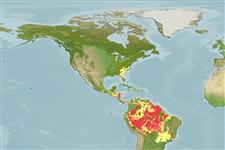| Native range | All suitable habitat |

|
| This map was computer-generated and has not yet been reviewed. |
| Hoplerythrinus unitaeniatus AquaMaps Data sources: GBIF OBIS |
Length at first maturity
Lm 16.5 range ? - ? cm
Human uses
Fisheries: commercial; aquarium: public aquariums
Phylogenetic diversity index
(Ref. 82805)
PD50 = 0.6250 many relatives (e.g. carps) 0.5 - 2.0 few relatives (e.g. lungfishes)
Trophic Level
(Ref. 69278)
3.4 ±0.49 se; Based on food items.
Resilience
(Ref. 69278)